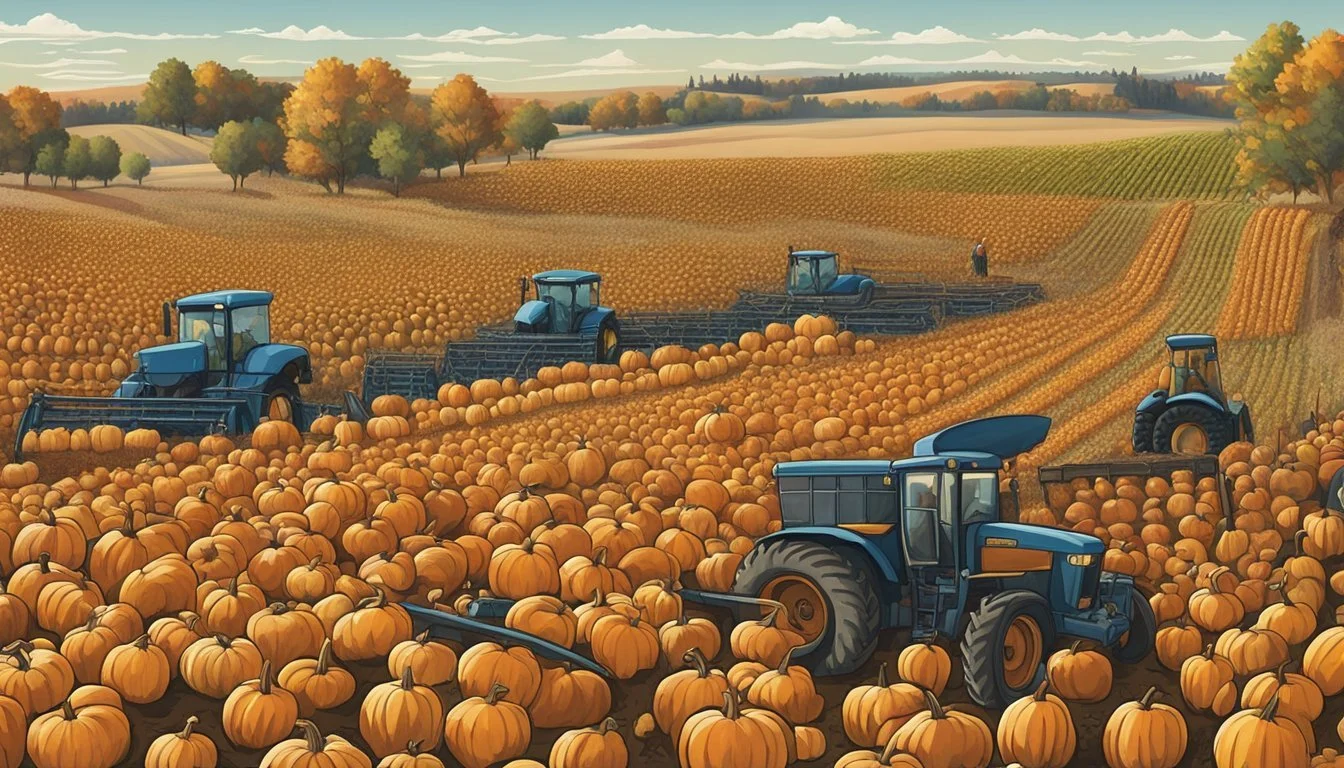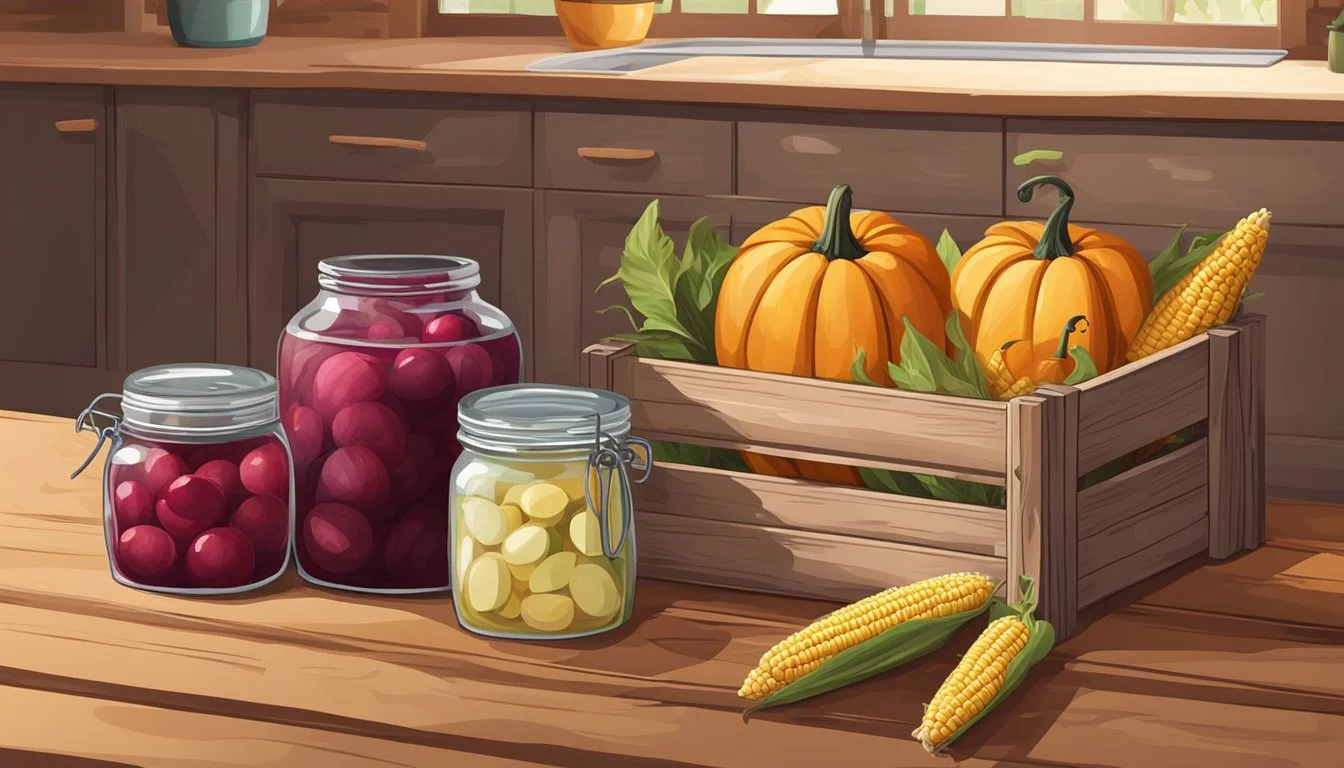South Dakota Seasonal Fruit & Vegetables in October
Your Harvest Guide
This Article is Part of our South Dakota Seasonal Fruit & Veg Calendar
In South Dakota, October marks a transitional period where the fall harvest is celebrated and the abundance of the season is at its peak. The state's climate, characterized by cold winters and warm summers, allows for a variety of fruits and vegetables to thrive, especially as the cooler fall temperatures set in. October is particularly significant for harvesting a range of produce that prefers the brisker weather.
The selection available in October is heavily influenced by the state's favorable conditions for cool-weather crops. Vegetables such as kale, spinach, beets (how long do beets last?), cauliflower, peas, radishes, broccoli (how long does broccoli last?), cabbage, and carrots (how long do carrots last?) make a strong showing in markets and on plates. These vegetables, known for their resilience to chillier temperatures, are often at their best during this month, offering both flavor and nutrition.
While the fall in South Dakota is not as vibrant for fruit as the summer months, there are still some fruits that reach their peak during this time. Blackberries (how long do blackberries last?), for instance, become sweeter and less tart the longer they remain on the bush and are typically harvested through mid-October. This period allows for the fruits to develop a richer flavor, an attribute that is much celebrated by local consumers and culinary enthusiasts.
Understanding South Dakota's Climate
South Dakota experiences a continental climate, with four distinct seasons and significant variations in temperature throughout the year. In the fall, weather patterns start to shift as the state prepares for the approaching winter.
Temperature: The average temperatures in October vary widely, often ranging from highs of 60°F (16°C) to lows around 34°F (1°C). This variation necessitates careful selection and planting of crops in tune with the changing environment.
Precipitation: Fall in South Dakota can be relatively dry, although occasional rainfall does occur. This season often provides a respite from the heavy summer rains, with lower humidity levels contributing to a more stable harvest period.
Hardiness Zones: The state falls within USDA hardiness zones 3 to 5. Hardiness zones are essential for understanding what plants will thrive in a given climate. South Dakota’s zones indicate that plants must be able to withstand cold winters with sub-zero temperatures.
Wind: The state can experience brisk winds, especially in the eastern regions, where the landscape is more open and flat. Wind can affect evaporation rates and soil moisture, both critical factors for fall agriculture.
Daylight: October days are shorter than summer months, with daylight hours decreasing as winter approaches. Shorter days mean less sunlight for photosynthesis, affecting growth rates and the timing of plant maturation.
Farmers and gardeners must consider these climatic factors to successfully grow seasonal fruits and vegetables. By understanding South Dakota’s climate, especially in fall, one can optimize planting schedules and ensure a bountiful harvest.
Key Harvests in October
October in South Dakota is a significant time for local produce, with a variety of crops reaching maturity and coming into season. This period sees the culmination of growth cycles for many fruits and vegetables, making it a busy month for harvests.
Fruit Harvests
In October, apples and pears are the primary fruit crops being harvested. They come in a range of varieties, each with their own distinct flavor profiles and uses.
Apples: Optimal for both eating fresh and for culinary uses, such as pies and ciders.
Pears: Ideal for canning or consuming directly off the tree.
Vegetable Harvests
October's cooler temperatures support a bountiful harvest of various vegetables that thrive in this climate. Root vegetables and hardy greens are especially prolific.
Pumpkins: A staple of the season, perfect for decorations as well as culinary uses.
Carrots: Their sweetness is often enhanced by the cold, making them a favored pick.
Squash: Includes varieties like butternut and acorn, known for their versatility in dishes.
Kale and Lettuce: These leafy greens are at their peak, offering crispness and flavor.
South Dakota's October harvest is integral for both local consumption and commercial distribution, ensuring a rich selection of fresh produce for the community.
Popular Fruits and Vegetables
In South Dakota, the month of October offers a bounty of fresh, flavorful produce. This period emphasizes the harvest of cruciferous vegetables, root vegetables, and a selection of orchard fruits that are not only rich in flavor but also offer significant nutritional benefits.
Cruciferous Vegetables
Cruciferous vegetables thrive in the cool South Dakota climate of October, providing a variety of options for healthy, hearty meals. Among the most sought-after are:
Broccoli: A nutritional powerhouse, broccoli is at its peak in October, offering high levels of vitamins A, C, and iron.
Brussels Sprouts: These small, cabbage-like vegetables grow well in cooler weather, possessing a sweet, nutty flavor after the first frost.
Cabbage: Another robust vegetable, cabbage is versatile in dishes, from salads to stews, and is rich in vitamins and fiber.
Cauliflower: Found in both white and colorful varieties, it delivers when it comes to fiber and B-vitamins.
Root Vegetables
October is also a prime time for delicious and nutritious root vegetables. They store well and are perfect for a variety of autumnal dishes.
Potatoes: A staple that can be prepared in countless ways, they are essential for their carbohydrates and potassium.
Beets: These have a deep, earthy flavor and are full of folate, manganese, and fiber.
Carrots: Known for their sweetness and rich in beta-carotene, carrots are a staple in many kitchens.
Turnips: Often underappreciated, turnips can be mashed, roasted, or added to soups. They provide vitamin C and calcium.
Orchard Fruits
The orchard fruits of South Dakota offer a sweet reprieve from the savory vegetables of fall.
Apples: Several varieties, such as Crispin and Fuji, are at their peak with a crisp texture and an ideal balance of sweet and tart.
Pears: With a buttery and slightly sweet taste, pears are excellent for both eating fresh and for preparing desserts.
Plums: Although less often highlighted, plums are available and provide a juicy, tangy option for snacks and cooking.
Each of these fruit and vegetable selections not only brings its unique flavor profile to the table but also a host of vitamins, minerals, and fibers that contribute to a balanced diet during the autumn season in South Dakota.
Seasonal Planting and Growth Cycles
October in South Dakota is characterized by the transition from the warm days of summer to the cooler temperatures of fall, affecting both planting and growth cycles of various crops. Gardeners tend to harvest the last yields of summer crops and prepare for the winter months.
Typically, by October, summer plants like zucchini, green beans, and other warm-season beans are reaching the end of their productive cycle, and gardeners are collecting the last of these crops. It is a time to clear these plants from the garden to make space for hardier varieties.
Meanwhile, cool-season crops that were planted in late summer will now be thriving. These include vegetables such as:
Peas: Able to withstand cooler temperatures, peas planted during late summer can be harvested in fall.
Spinach: Known for its cold hardiness, spinach grows well into the fall season.
During this month, South Dakota gardeners may also see the growth of fall crops such as broccoli, cabbage, and carrots which were planted earlier in the season. These vegetables can handle the mild frosts common in October, and some root vegetables may even benefit in flavor from the cooler temperatures.
While October is not a prime planting month in the state, it is essential for garden preparations for the next growing season. Gardeners often use this time to amend soil, add mulch, and plan for spring. Looking ahead, crops durable against the harsh cold, such as garlic, are typically planted in the fall to overwinter and sprout in spring.
Agricultural Practices in South Dakota
South Dakota's agricultural practices are carefully adapted to its unique climate and soil conditions, focusing on sustainable crop production and effective pest and disease management. These practices contribute to the success of the state's harvests, including those of October fruits and vegetables.
Pest Control and Disease Management
In South Dakota, farmers implement integrated pest management (IPM) practices to reduce the impact of pests and diseases on crops. This includes:
Regular monitoring of pest populations
Employing biological control agents such as beneficial insects
Utilizing disease-resistant crop varieties
Crop rotation is also a key practice, helping to disrupt the life cycles of pests and reducing disease incidence. Pesticides are applied when necessary, but always with caution to minimize environmental impact.
Soil and Nutrition
For soil and nutritional management, South Dakota farmers prioritize maintaining soil health to ensure the sustainability of agriculture. Practices include:
Applying compost and green manures to enhance soil fertility
Conducting soil tests to monitor nutrient levels and tailor fertilization plans accordingly
Farmers are aware of the different hardiness zones across South Dakota and choose crops that are well-suited to the local soil and climatic conditions. Regularly incorporating organic matter, such as yard waste and compost, into the soil improves its structure and nutrition, promoting healthy crop growth.
Where to Buy Seasonal Produce
In South Dakota, October's seasonal bounty is plentiful, and those seeking the freshest produce have several options. Farmers markets across the state serve as prime hubs for procuring a variety of local fruits and vegetables. At these markets, shoppers can interact directly with growers to learn about the origin and cultivation methods of their food. A list of markets can be found on the South Dakota Department of Agriculture website.
For a more personal touch, local farms often offer the chance to buy produce directly from their premises. Many of these farms practice organic farming methods, ensuring that the produce is grown without synthetic pesticides or fertilizers.
Consumers looking for convenience without compromising on quality can turn to specialized organic stores in South Dakota. These stores prioritize local and organically certified produce, supporting sustainable agriculture in the region.
Below is a simplified table highlighting the typical places to find seasonal produce in South Dakota:
Source Features Farmers Market Diverse selection, direct from grower, community-oriented Local Farms Freshness, farm-to-table experience Organic Stores Certified organic, supports local agriculture
Those interested in seasonal fruits and vegetables should consider these options for the freshest and most flavorful produce available in South Dakota during the month of October.
Cooking and Storing Seasonal Produce
October in South Dakota offers an abundance of root vegetables and winter squash that provide both nutrition and flavor. Proper cooking and storage methods are essential to maximize these produce items' taste and longevity.
Preservation Techniques
Canning: Preserve the harvest of vegetables like tomatoes and green beans by canning them. These can be processed using a boiling water canner for high-acid vegetables or a pressure canner for low-acid ones to sustain their nutritional value and flavor.
Tomatoes: Simply peeled, quartered, and canned.
Green Beans: Blanched and canned using a pressure canner.
Freezing: To retain the peak nutritional content and texture of vegetables, blanch them before freezing.
Corn: Blanch for 4 minutes, cool, and cut kernels from cob before freezing.
Carrots: Peel, slice, and blanch for 2 minutes.
Root Vegetables: Store in a cool, dry place. Correct storage can ensure vegetables like beets and carrots last through the winter.
Recipes and Cooking Tips
Root vegetables and winter squash from South Dakota's October harvest are ideal for a range of recipes from salads to tarts.
Roasting: This method enhances the natural sugars in vegetables like beets and carrots, resulting in a caramelized flavor.
Beets: Wash, peel, and chop before roasting at 400°F for 30-40 minutes.
Carrots: Peel, slice, and toss with olive oil and herbs, roast at 425°F for 20-25 minutes.
Winter Squash: Versatile in dishes, they can be transformed into savory soups or spiced tarts.
Butternut Squash Soup: Cube, cook until tender, puree, and season for a warm, creamy soup.
Acorn Squash: Halved, seeded, and baked with a touch of maple syrup (how long does maple syrup last?) for a sweet side dish.
Root vegetables can also be incorporated into salads for a nutritious crunch.
Salads: Shred raw beets and carrots, then combine with greens and a vinaigrette for a fresh, earthy salad.
When cooking and storing October produce, it's important to consider each item's unique requirements to maintain their quality and nutrient content.
Conclusion
South Dakota's October harvest offers a plethora of fruits and vegetables that are not only fresh but also support local communities. By opting for locally grown produce, consumers participate in a sustainable food system that benefits both the environment and the economy.
In October, South Dakota's harvest includes crops like:
Vegetables:
Carrots
Spinach
Pumpkins
Squash
Fruits:
Apples
Blackberries (early October)
Buying local produce during this month ensures that individuals enjoy the freshest foods at their peak of flavor while reducing food miles. This practice also fosters community ties as consumers engage more with South Dakota farmers and contribute to the local agricultural landscape.
Moreover, sustainability is at the forefront of choosing local, in-season produce. It often requires fewer resources to grow and transport, thereby reducing its environmental footprint.
In terms of availability, here's what to expect:
Produce Type Availability Status Fruits Apple and early blackberries Vegetables Wide variety, peak season
Supporting local produce in October not only offers nutritional benefits but also strengthens the agricultural fabric of South Dakota, underscoring the importance of seasonal eating for sustainability and community development.









